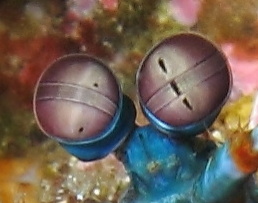Mantis shrimp eyes collect a staggering amount of information, feeding into a tiny brain – leaving scientists wondering how they process it all.
A short explainer video makes this an accessible resource for years 5 through 10 thinking about specific adaptations and genetic evolution from the Biological Sciences curriculum and light wave energy from the Physical Sciences curriculum.
Word Count & Video Length: 571 & 1.36m

The mantis shrimp may be one of the most surprising creatures on Earth.
Tucked away under beneath the heads of the colourful coral dwellers are two devastating weapons – barbed arms which they can unfurl at phenomenal speeds. In fact, they can punch so hard and fast that the water around the arm boils.
However, as amazing as their martial arts ability is, it’s their complex colour vision which is particularly surprising. While we have three colour receptors in our eyes – blue, green and red – the mantis shrimp packs 12 different colour receptors.
They can also perceive UV light, and two kinds of polarised light – far more than what mere humans can.
And yet, they have tiny brains which are somehow able to make sense of a breathtaking amount of visual input.
Now, researchers from the University of Queensland have discovered how their brain handles the most complex visual system of any living animal. The study may help researchers better understand the evolution of colour vision in the animal kingdom.
Their results are published in the Journal of Comparative Neurology.
“Mantis shrimp have four times as many colour receptors as we humans do: we have three – red, green, and blue – and they have 12,” says Justin Marshall from UQ’s Queensland Brain Institute.
“They sample light we can’t see and they also sample light we do see in a completely different way, and as a result, mantis shrimp have much more visual information coming in than we do.
“So the question is, why don’t their tiny brains explode?”
“Why don’t their tiny brains explode?”
The researchers have shed new light on how the tiny crustaceans process and remember visual information by mapping a region of the mantis shrimp brain.
Marshall says the answer appeared to lie in the reniform body, a region of the crustacean’s brain found in each of the eye stalks that support its two protruding eyes.
“Because of its position, it has long been thought to act as a processing centre for any visual information passing from the eye to the brain.”
“Using a variety of imaging techniques, we traced connections made by neurons in the reniform body and discovered that it contains a number of distinct, interacting subsections,” says Hanne Thoen, who led the research.

“They have the world’s most complex retina, so it’s not surprising, but comforting to find out they have a complex centre to deal with that input.
“Mantis shrimp most likely use these subsections to process different types of colour information coming in, and organise it in a way that makes sense to the rest of the brain.
“This would enable them to interpret a staggering amount of visual information very quickly.”
The researchers say they were intrigued to discover a neural connection between the reniform body and a brain region known to be involved with memory.
This connection may allow mantis shrimp to store visual memories.
“It most likely enables them to remember something that’s good to eat or something else they should run away from,” Thoen says.
“It will be fascinating to now take the study forward and figure out how all the subunits of the reniform body work together to do whatever it is these animals need to make sense of their world.”
Login or Sign up for FREE to download a copy of the full teacher resource





